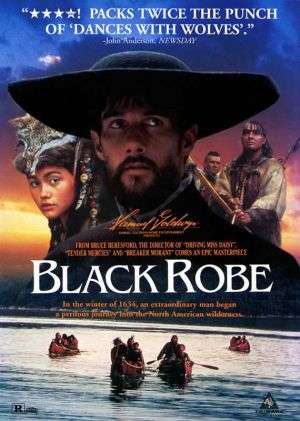Black Robe

Jesuit missionary Father LaForgue is anxious to evangelize the indigenous peoples of 17th century interior Canada. He sets out from Quebec with the guidance of Chomina, an experienced Algonquin traveler, Chomina's family, several other natives and the non-Jesuit carpenter, Daniel. LaForgue struggles with his deeply-held religious convictions as he encounters a vast, alien landscape; meets various hostile natives and confronts cultural attitudes he fails to understand.
Black Robe is a 1985 novel by Brian Moore. Moore also wrote the screenplay for the 1991 film of the same name.
This article mainly deals with the film.
Tropes used in Black Robe include:
- Exclusively Evil: Subverted. Daniel thinks this of the Iroquois. Chomina points out that that's just how life is there.
- Annoying Arrows: Averted in cringe-inducing detail.
- Big Little Man: Father LaForgue is harangued by the shaman Mestigoit, who is filmed close to the camera—it's only when he comes face-to-face with LaForgue (who is sitting down) that we realise how short he is.
- Braids, Beads, and Buckskins: The clothing of the natives and colonists is quite accurate.
- Clothing Damage: LaForgue and Daniel's clothes gradually get dirtied and torn. LaForgue tears up part of his robe to make a bandage for Chomina and Daniel is wearing buckskins almost exclusively by the end.
- Culture Clash
- Dies Wide Open: Lots of people
- Dreaming of Things to Come: As usual, quite prophetic. Chomina wishes he had acted upon them much sooner.
- Everyone Calls Him "Barkeep": The natives call the missionaries black robes due to their clothing. Once he leaves the colonial settlement LaForgue is almost exclusively referred to as "Black Robe". Daniel even calls him that once.
- Foreshadowing: Through the above-mentioned dreams.
- Fake Nationality: Many of the native characters, major, secondary and extras, were played by non-native actors.
- Fingore: All over the place
- Going Native: Subverted. Daniel seems to be going down this road but after the horrific encounter with the Iroquois Chomina asks him:
You want to be like us? What do you think now?
- I Gave My Word: Several of Chomina's companions want to abandon or kill LaForgue and Daniel, but Chomina promised Champlain they'd be protected.
- Indian Maiden: Kind of. Annuka is The Chief's Daughter who falls in love with a white man. However, she very much averts the Damsel in Distress stereotype and is much more hot-headed and impatient than her father.
- Injun Country: Averted
- Mighty Whitey: It's a lot more subtle than you might expect for a film like this but it's the core of the message.
- The Missionary
- Noble Savage: Brutally subverted.
- Not So Different: On a cultural level. Moore compares the superstition of the natives with the Catholic beliefs of the missionaries. In the film Daniel suggests this point to LaForgue. Visual juxtaposition to this effect is all over the place.
- The Quest: Reaching the Huron mission.
- Scenery Porn: Wow, Canada.
- Shoot the Shaggy Dog
- Translation Convention: Played straight for French, which is mostly rendered in English (mostly by native French-speakers, too, interestingly enough). Averted for the indigenous languages.
This article is issued from Allthetropes. The text is licensed under Creative Commons - Attribution - Sharealike. Additional terms may apply for the media files.